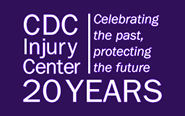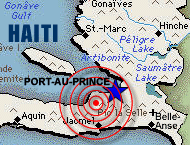Categories: CDC Injury Center, Injury Response, Motor Vehicle Safety
August 21st, 2012 1:05 pm ET -

On this Boulevard de La Madeleine, Paris France, Dr. David Sleet was struck by a car – his pedestrian story impacts the work he does for the CDC Injury Center.
Guest blogger: David Sleet, PhD
I was a graduate student in Paris in 1972 – my first solo trip to the city of light. It was dusk and a group of classmates and I made our way to Boulevard de La Madeleine to shop. The narrow, seemingly pedestrian-friendly boulevard was alive, and it was cluttered with tourists and Parisians taking in the last minutes of light.
 2 Comments -
Read more
2 Comments -
Read more

Categories: CDC Injury Center, Home & Recreational Safety, Injury Response, Motor Vehicle Safety, Traumatic Brain Injury, Violence Prevention
January 23rd, 2012 4:29 pm ET -
Dr. Linda C. Degutis, DrPH, MSN

Please visit the CDC Injury Center 20th Anniversary web site for toolkits, talking points, and other resources to help us commemorate our 20 years, and to spread the word about injury and violence prevention.
I have many stories that I could tell about injuries and violence, from both my professional and personal lives. One of my nephews was diagnosed with depression when he was in high school. He was treated, eventually finished school, and graduated from college at the age of 25. He was accepted to law school, but tragically, he died by suicide shortly after receiving his acceptance letter. Working in trauma and emergency care for many years, I saw the impacts that deaths and injuries had on families like mine. These experiences compelled me to do something to prevent other families from suffering. Being at CDC where so many people are dedicated to preventing these kinds of tragedies gives me an opportunity to ensure that fewer families will experience such loss and disruption.
 2 Comments -
Read more
2 Comments -
Read more

Categories: CDC Injury Center, Home & Recreational Safety, Injury Response, Motor Vehicle Safety, Traumatic Brain Injury, Violence Prevention
April 14th, 2011 3:24 pm ET -
Dr. Linda C. Degutis, DrPH, MSN
 Last week, National Public Health Week (NPHW) focused on injury and violence prevention – keeping people safe and realizing the goal of ensuring that people live injury-free. It was a week where a great deal of attention was focused on injury and violence and the health and societal effects of both. The joint Safe States Alliance, Society for the Advancement of Violence and Injury (SAVIR) & CDC’s Injury Center Conference in Coralville, Iowa brought together over 350 injury and violence prevention practitioners and researchers, creating a forum for research informing practice and practice informing research, and an opportunity to explore evidence-based policy and practice. It was a great week, and the first time that NPHW focused on injury and violence prevention.
Last week, National Public Health Week (NPHW) focused on injury and violence prevention – keeping people safe and realizing the goal of ensuring that people live injury-free. It was a week where a great deal of attention was focused on injury and violence and the health and societal effects of both. The joint Safe States Alliance, Society for the Advancement of Violence and Injury (SAVIR) & CDC’s Injury Center Conference in Coralville, Iowa brought together over 350 injury and violence prevention practitioners and researchers, creating a forum for research informing practice and practice informing research, and an opportunity to explore evidence-based policy and practice. It was a great week, and the first time that NPHW focused on injury and violence prevention.
 9 Comments -
Read more
9 Comments -
Read more

Categories: CDC Injury Center, Home & Recreational Safety, Injury Response, Motor Vehicle Safety, Traumatic Brain Injury, Violence Prevention
April 4th, 2011 8:00 am ET -
Dr. Linda C. Degutis, DrPH, MSN

Dr. Linda C. Degutis, DrPH, MSN
Looking back at my experience in the field of injury prevention and control, I can easily see how important partnerships have been in our efforts to decrease the toll that injury takes on people of all ages. We have come a long way over the past few decades, but face new challenges in enabling people to live injury free lives. We face the challenges of an aging population, with increased risk of falls; various forms of violence, including violence among youth which so often has its roots in early childhood, and has health impacts far beyond the immediate effect of injuries related to violence; motor vehicle related injuries that affect vehicle occupants as well as those who share the road with motor vehicles; emerging problems with narcotic prescription drug abuse and overdoses; suicide and injuries with long-term effects among our troops who are returning from their missions. While efforts in these areas may involve different partners and different approaches, they are all amenable to a public health approach.
 4 Comments -
Read more
4 Comments -
Read more

Categories: Injury Response
January 29th, 2010 3:28 pm ET -
 Witnessing devastation like what we have seen in Haiti since the earthquake on January 12 leaves everyone asking what little bit they can do to help. What is certain is that a natural disaster of this scale requires a coordinated response across many disciplines and a sustained international effort from public health and relief organizations. The CDC Injury Center is supporting an agency wide effort to work with partners and immediately address the public health needs of the Haiti earthquake survivors.
Witnessing devastation like what we have seen in Haiti since the earthquake on January 12 leaves everyone asking what little bit they can do to help. What is certain is that a natural disaster of this scale requires a coordinated response across many disciplines and a sustained international effort from public health and relief organizations. The CDC Injury Center is supporting an agency wide effort to work with partners and immediately address the public health needs of the Haiti earthquake survivors.
 2 Comments -
Read more
2 Comments -
Read more

Categories: Injury Response
December 22nd, 2009 5:23 pm ET -
Louise Galaska, MPA
Whether at home, on the road, or in relationships, people who drink too much are at a higher risk of sustaining injury or causing injury to others. Excessive drinking is the leading risk factor for injury in the United States and the third leading cause of preventable death. The CDC’s Injury Center supports alcohol Screening and Brief Intervention (SBI), a clinical preventive service now provided in many Level I trauma centers. The American College of Surgeons Committee on Trauma (COT) requires Level I trauma centers to have a mechanism to identify patients whose drinking is unhealthy and provide on-the-spot brief counseling. This requirement of screening and brief intervention is an evidence-based two-step process: conducting a screening and implementing brief intervention if the screening is positive for risky alcohol use.
 2 Comments -
Read more
2 Comments -
Read more

Categories: Injury Response
June 29th, 2009 4:30 pm ET -
Dr. Ileana Arias
Our goal at the Injury Center is to prevent injuries. Yet we know that despite all of our efforts, injuries will occur. So we believe it also is our professional responsibility to help ensure the best response when they do.
 Post a Comment -
Read more
Post a Comment -
Read more

Categories: Injury Response
September 7th, 2008 3:30 pm ET -
Dr. Ileana Arias
In an instant, an explosion or blast can wreak havoc; causing numerous injuries not commonly seen after natural disasters such as floods or hurricanes. And unfortunately, as many of us see daily through news reports, explosions are by far the most common cause of injuries associated with terrorism.
 Post a Comment -
Read more
Post a Comment -
Read more



 Last week,
Last week, 
 Witnessing devastation like what we have seen in Haiti since the earthquake on January 12 leaves everyone asking what little bit they can do to help. What is certain is that a natural disaster of this scale requires a coordinated response across many disciplines and a sustained international effort from public health and relief organizations. The
Witnessing devastation like what we have seen in Haiti since the earthquake on January 12 leaves everyone asking what little bit they can do to help. What is certain is that a natural disaster of this scale requires a coordinated response across many disciplines and a sustained international effort from public health and relief organizations. The 
